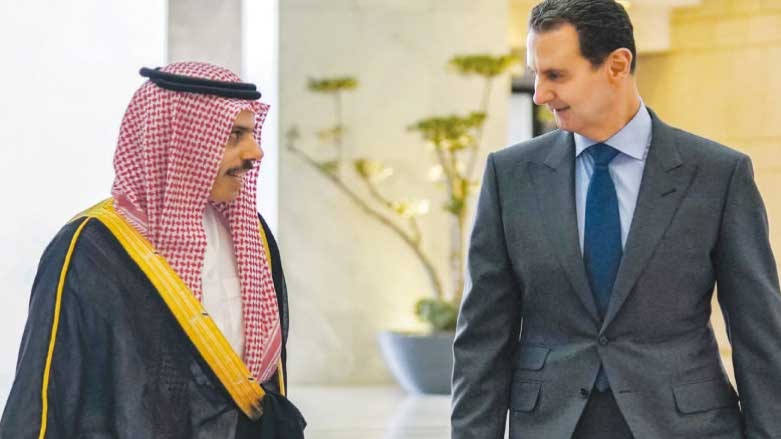U.S. Reaffirms Position on Isolating Syria, as Arab Reconciliation Continues
"We have stressed to regional partners” that “any credible step to improve the humanitarian and security situation for Syrians should be front and center in any engagement," Patel said.

WASHINGTON DC, United States (Kurdistan 24) –Speaking to journalists on Thursday, State Department Deputy Spokesperson, Vedant Patel, stated that the U.S. continued to seek to maintain Syria’s isolation, even as Arab reconciliation with the regime of Bashar al-Assad proceeds.
Asked about a Saudi-led drive to normalize Arab ties with Damascus, Patel affirmed, “Our position has not changed.”
“We will not normalize relations with the Assad regime, absent authentic progress towards a political solution to the underlying conflict,” he said. “We have stressed to regional partners” that “any credible step to improve the humanitarian and security situation for Syrians should be front and center in any engagement.”
Background
On Tuesday, the Foreign Minister of Saudi Arabia, Prince Faisal bin Farhan, visited Damascus and met with Assad, amid a Saudi initiative to return Syria to the Arab League.
Farhan’s trip was the first visit of a senior Saudi official to Syria in twelve years—since that country’s civil war began in 2011, amid the Arab “spring,” the popular unrest that overthrew rulers in Libya, Tunisia, Egypt, Sudan, and Yemen.
But Assad’s repression in the face of the unrest that arose in Syria was particularly harsh. That includes the repeated use of chemical weapons against the Syrian population.
Moreover, starting in late Sept. 2015, Moscow began to intervene in that country’s civil war on behalf of the Asad regime, with Russia’s air force targeting the opposition to the regime. It seemed then that the regime might well fall, as the other Arab regimes had done. However, with time, it became apparent that Moscow’s intervention had stabilized the situation and saved Assad’s regime.
Notably, the Russian intervention followed soon after Russian President Vladimir Putin addressed the opening of the U.N. General Assembly on Sept. 28.
It was the first time in a decade that Putin had traveled to New York for the event, and in his speech to the assembled diplomats, he provided the rationale for supporting Assad and similar figures.
Before the assembled diplomats, Putin denounced the U.S. “export of revolutions, this time of so-called democratic ones,” and he continued, “rather than bringing about reforms, an aggressive foreign interference has resulted in a brazen destruction of national institutions and the lifestyle itself.”
“Instead of the triumph of democracy and progress,” Putin added, “we got violence, poverty and social disaster,” as he defended the Assad regime.
The Russian bombing of the Syrian opposition to the Assad regime began two days later.
Saudi Reconciliation with China as Precursor
The Saudi move toward reconciliation with Syria, as reflected in Farhan’s visit to Damascus, follows a reconciliation in March between Riyadh and its long-time rival, Tehran.
That surprise accord, in which the two countries agreed to re-establish diplomatic relations, was brokered by China.
Read More: Iran, Saudi to restore ties in China-brokered deal
Although some analysts saw the accord as a Chinese move to upstage the U.S. in the region, Washington repeatedly welcomed the agreement.
“From our perspective, anything that can help reduce tensions, avoid conflict, and curb in any way dangerous or destabilizing actions by Iran is a good thing,” U.S. Secretary of State Antony Blinken affirmed following the conclusion of the accord.
Read More: US again endorses Saudi-Iran agreement that China mediated
The effect of the Saudi-Iranian reconciliation became quickly apparent in Yemen. Like Syria, Yemen fell into civil war as a result of the “Arab spring.” But there was one significant difference. In Yemen, the popular protests led to the fall of the old regime.
Subsequently, Iranian-backed rebels—the Houthis—gained control over much of the country, including the capitol, Sana’a, and Yemen’s civil war became a proxy war between Saudi Arabia and Iran. Now, with the Saudi-Iranian reconciliation proceeding. at least some aspects of that conflict are decreasing.
Earlier this week, a three-day prisoner exchange was conducted which freed nearly 900 individuals from both sides, who had been detained over the course of the conflict.
The ultimate objective is to end the conflict, which has “killed hundreds of thousands,” as Al-Jazeera reported, and created “a humanitarian disaster that has pushed the country to the brink of famine”—an assessment that is really not so different from what Putin told the U.N. General Assembly eight years ago.
